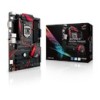Asus ROG STRIX B250H GAMING User Guide - Page 63
Monitor menu, 3.8 Boot menu, Q-Fan Configuration, Fast Boot [Enabled]
 |
View all Asus ROG STRIX B250H GAMING manuals
Add to My Manuals
Save this manual to your list of manuals |
Page 63 highlights
3.7 Monitor menu The Monitor menu displays the system temperature/power status, and allows you to change the fan settings. Q-Fan Configuration The subitems in this menu allows you to configure the Q-Fan features. Qfan Tuning Click this item to automatically detect the lowest speed and configure the minimum duty cycle for each fan. 3.8 Boot menu The Boot menu items allow you to change the system boot options. Fast Boot [Enabled] [Enabled] [Disabled] Select to accelerate the boot speed. Select to go back to normal boot speed. The following item appears only when you set Fast Boot to [Enabled]. Next Boot after AC Power Loss [Normal Boot] [Normal Boot] Returns to normal boot on the next boot after AC power loss. [Fast Boot] Accelerates the boot speed on the next boot after AC power loss. CSM (Compatibility Support Module) Allows you to configure the CSM (Compatibility Support Module) items to fully support the various VGA, bootable devices and add-on devices for better compatibility. Launch CSM [Enabled] [Auto] The system automatically detects the bootable devices and the add-on devices. [Enabled] For better compatibility, enable the CSM to fully support the non-UEFI driver add-on devices or the Windows® UEFI mode. [Disabled] Disable the CSM to fully support the Windows® Security Update and Security Boot. The following four items appear when you set Launch CSM to [Enabled]. Boot Device Control [UEFI and Legacy OPROM] Allows you to select the type of devices that you want to boot up. Configuration options: [UEFI and Legacy OPROM] [Legacy OPROM only] [UEFI only] Boot from Network Devices [Legacy only] Allows you to select the type of network devices that you want to launch. Configuration options: [Ignore] [Legacy only] [UEFI driver first] Chapter 3 ASUS STRIX B250H GAMING 3-15















